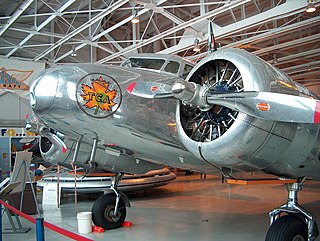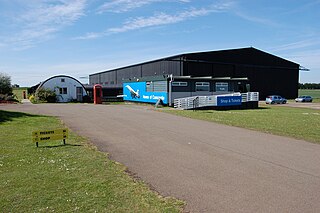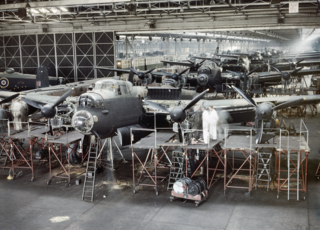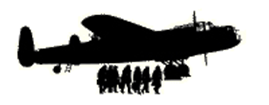
The Avro Anson is a British twin-engine, multi-role aircraft built by the aircraft manufacturer Avro. Large numbers of the type served in a variety of roles for the Royal Air Force (RAF), Fleet Air Arm (FAA), Royal Canadian Air Force (RCAF), Royal Australian Air Force and numerous other air forces before, during, and after the Second World War.

The Avro York was a British transport aircraft developed by Avro during the Second World War. The design was derived from the Avro Lancaster heavy bomber, several sections of the York and Lancaster being identical. Due to the importance of Lancaster production, York output proceeded slowly until 1944, after which a higher priority was placed upon transport aircraft.

The Avro 504 was a First World War biplane aircraft made by the Avro aircraft company and under licence by others. Production during the war totalled 8,970 and continued for almost 20 years, making it the most-produced aircraft of any kind that served in any military capacity during the First World War. More than 10,000 were built from 1913 until production ended in 1932.

Trans-Canada Air Lines was a Canadian airline that operated as the country's flag carrier, with corporate headquarters in Montreal, Quebec. Its first president was Gordon Roy McGregor. Founded in 1937, it was renamed Air Canada in 1965.

The Martin JRM Mars is a large, four-engined cargo transport flying boat designed and built by the Martin Company for the United States Navy during World War II. It was the largest Allied flying boat to enter production, although only seven were built. The United States Navy contracted the development of the XPB2M-1 Mars in 1938 as a long-range ocean patrol flying boat, which later entered production as the JRM Mars long-range transport.

The National Museum of Flight is Scotland's national aviation museum, at East Fortune Airfield, just south of the village of East Fortune, Scotland. It is one of the museums within National Museums Scotland. The museum is housed in the original wartime buildings of RAF East Fortune which is a well preserved World War II airfield. As a result of this the entire site is a scheduled monument with no permanent structures added by the museum. The hangars, control tower and stores were designated as Category B listed buildings by Historic Scotland, but this designation was removed in 2013 as they were already covered by the stricter scheduling.

Fantasy of Flight is an aviation museum in Polk City, Florida.

The Lincolnshire Aviation Heritage Centre is an aviation museum in East Kirkby, Lincolnshire, England. It was opened to the public in 1988 by Lincolnshire farmers Fred and Harold Panton, as a memorial to their older brother, Christopher Whitton Panton, who was killed on operations during the Second World War.

The Canadian Warplane Heritage Museum is an aviation museum located at the John C. Munro Hamilton International Airport in Mount Hope, Ontario, Canada. The museum has 47 military jets and propeller-driven aircraft on display.

Woodford Aerodrome is a former airfield and aircraft factory at Woodford, Greater Manchester, England, 6 NM north of Macclesfield. It was opened by the Avro company after the First World War and became an important production centre for military aircraft in the Second World War. Notable planes made at the factory include the Avro Anson, Avro Lancaster, Avro Shackleton and Avro Vulcan.

Avro VulcanXH558Spirit of Great Britain was the last remaining airworthy example of the 134 Avro Vulcan jet-powered delta winged strategic nuclear bomber aircraft operated by the Royal Air Force during the Cold War. It was the last Vulcan in military service, and the last to fly at all after 1986. It last flew on 28 October 2015.
The South African Air Force Museum houses exhibits and restores material related to the history of the South African Air Force. The museum is divided into three locations, AFB Swartkop outside Pretoria, AFB Ysterplaat in Cape Town and at the Port Elizabeth airport.

Avro Lancaster PA474 is a four-engined, Second World War era, Avro Lancaster heavy bomber operated by the Royal Air Force Battle of Britain Memorial Flight as a tribute to all members of Bomber Command during the Second World War.

The Canadian Air and Space Conservancy was an aviation museum that was located in Toronto, Ontario, featuring artifacts, exhibits and stories illustrating a century of Canadian aviation heritage and achievements. The museum was located in a hangar that once housed the original de Havilland Canada aircraft manufacturing building, but in September 2011 the museum and all of the other tenants in the building were evicted by the landlord, the Crown Corporation, PDP. The site was slated for redevelopment as a new sports centre but after closing the museum the development was placed on hold. The museum is developing a new location and its collections are currently not available for public viewing.

The Aviation Heritage Museum is a museum created and maintained by the RAAF Association of Western Australia. It houses many military and civilian aircraft, aircraft replicas and aircraft engines, of types that have served in the Royal Australian Air Force or have relevance to aviation in Western Australia. It is located in the suburb of Bull Creek in Perth, Western Australia.

The Bomber Command Museum of Canada, formerly the Nanton Lancaster Society Museum, is an aviation museum in Nanton, Alberta. The museum opened in 1986 and was founded to protect and restore Avro Lancaster FM159, one of only 4 remaining Lancasters in the world, two of which are flying and two are taxi only. It has since grown to include a large collection of aircraft, many of which were used during the War by the British Commonwealth Air Training Plan.

FM213 is an Avro Lancaster, one of only two airworthy examples in the world. It was built in Malton, Ontario at Victory Aircraft as construction number 3414 and rolled out in July 1945. Built as a Mark X bomber, it was no longer needed in Europe and transferred directly to storage at CFB Trenton. It was later modified for maritime reconnaissance but damaged during delivery and underwent repairs in 1953. FM213 spent the next ten years as a search and rescue aircraft over the Atlantic Ocean.

















